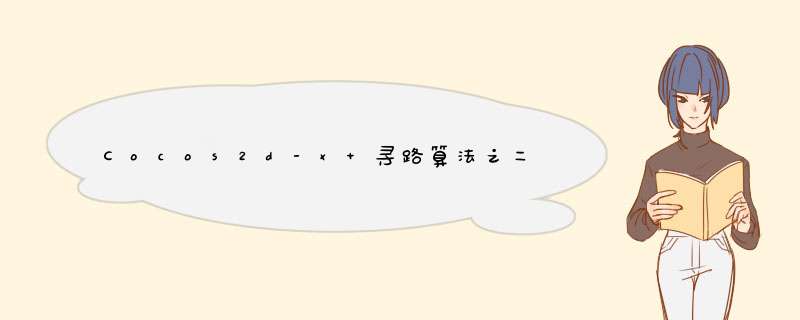
转自--->Waiting For You:http://www.waitingfy.com/archives/831
figure 1
接上一篇《Cocos2d-x 寻路算法之一 距离优先》,看这个图,我们发现这个寻路算法有点傻,明明终点在右侧却每个方向都找。难道没有其他办法了吗?从现实生活中我们知道东西如果在东边,当然是往东边搜索才是最好的办法。
2.开始动手
figure 2
计算机中如何表示离目标近呢? 用图来解释就是这样的,目标在右上角,我们往右走,从X轴的角度来说离目标又近了一步,同理往上走是在Y轴上里目标近一步。最好的一步应该是图中-2的点,X轴和Y轴同时离目标近了一步。简单地转换成代码就是下面的这样:
?
| 1 2 3 4 5 6 7 8 9 | bool comparebyWhichNearerGoalSimpleWay(Cell *c1,Cell *c2){ int distanceOfC1AndGoal = abs (g_goalX - c1->getX()) + (g_goalY - c1->getY()); distanceOfC2AndGoal = (g_goalX - c2->getX()) + (g_goalY - c2->getY()); if (distanceOfC1AndGoal <= distanceOfC2AndGoal){ return false ; @H_404_112@ } else { true ; } } |
扔到heap的比较条件中我们轻易地就实现了按照离目标距离优先的寻路算法,startPathFinding整个方法都不要改,只需要传进去上面提到的比较方法就行了。
9 10 11 12 13 14 15 16 17 18 19 20 21 22 23 24 25 26 27 28 29 30 31 32 33 34 35 36 37 38 39 40 41 42 43 44 @H_419_221@ 45 46 47 48 49
typedef bool (*compareTwoCells)(Cell *c1,Cell *c2); voID HelloWorld::startPathFinding(compareTwoCells compareMethod, startX,monospace!important; border:0px!important; bottom:auto!important; float:none!important; height:auto!important; left:auto!important; outline:0px!important; overflow:visible!important; position:static!important; right:auto!important; top:auto!important; vertical-align:baseline!important; wIDth:auto!important; min-height:inherit!important; background:none!important"> startY,monospace!important; border:0px!important; bottom:auto!important; float:none!important; height:auto!important; left:auto!important; outline:0px!important; overflow:visible!important; position:static!important; right:auto!important; top:auto!important; vertical-align:baseline!important; wIDth:auto!important; min-height:inherit!important; background:none!important"> goalX,monospace!important; border:0px!important; bottom:auto!important; float:none!important; height:auto!important; left:auto!important; outline:0px!important; overflow:visible!important; position:static!important; right:auto!important; top:auto!important; vertical-align:baseline!important; wIDth:auto!important; min-height:inherit!important; background:none!important"> goalY){ Cell *startCell = _m_Map.Get(startX,startY); vector<Cell*> vecCells; vecCells.push_back(startCell); @H_404_112@ make_heap(vecCells.begin(),vecCells.end(),compareMethod); startCell->setMarked( true ); Cell *NowProcessCell; while (vecCells.size() != 0){ pop_heap(vecCells.begin(),compareMethod); NowProcessCell = vecCells.back(); vecCells.pop_back(); (NowProcessCell->getX() == _goalX && NowProcessCell->getY() == _goalY){ //the goal is reach return ; } for ( i = 0; i < 8; ++i){ //check eight direction indexX = NowProcessCell->getX() + DIRECTION[i][0]; indexY = NowProcessCell->getY() + DIRECTION[i][1]; (indexX >= 0 && indexX < xlineCount && indexY >= 0 && indexY < ylineCount && _m_Map.Get(indexX,indexY)->getpassable() == ){ //check is a OK cell or not Cell *cell = _m_Map.Get(indexX,indexY); float beforedistance = disTANCE[i] * cell->getWeight() + _m_Map.Get(NowProcessCell->getX(), NowProcessCell->getY())->getdistance(); //calculate the distance (cell->getMarked() == false ){ cell->setMarked( ); cell->setLastX(NowProcessCell->getX()); cell->setLastY(NowProcessCell->getY()); cell->setdistance(beforedistance); vecCells.push_back(cell); //only push the unmarked cell into the vector push_heap(vecCells.begin(),compareMethod); @H_387_404@ { // if find a lower distance,update it (beforedistance < cell->getdistance()){ cell->setdistance(beforedistance); cell->setLastX(NowProcessCell->getX()); cell->setLastY(NowProcessCell->getY()); //distance change,so make heap again } } } } } } startPathFinding(comparebyWhichNearerGoalSimpleWay,_playerX,_playerY,_goalX,_goalY); //demo 3.离目的地的距离优先效果图:
figure 3
我们惊奇地发现似乎我们成功了,就用了9步就找到了目的地!
4.算法改进
从图2中我们用的是X轴和Y轴上的相对距离,并不是真正的物理距离,意识到这个问题我们马上修改了比较函数。物理距离当然容易算了,公式如下:
换成C++函数就是下面的样子:
15
c1X,monospace!important; border:0px!important; bottom:auto!important; float:none!important; height:auto!important; left:auto!important; outline:0px!important; overflow:visible!important; position:static!important; right:auto!important; top:auto!important; vertical-align:baseline!important; wIDth:auto!important; min-height:inherit!important; background:none!important"> c1Y,monospace!important; border:0px!important; bottom:auto!important; float:none!important; height:auto!important; left:auto!important; outline:0px!important; overflow:visible!important; position:static!important; right:auto!important; top:auto!important; vertical-align:baseline!important; wIDth:auto!important; min-height:inherit!important; background:none!important"> c2X,monospace!important; border:0px!important; bottom:auto!important; float:none!important; height:auto!important; left:auto!important; outline:0px!important; overflow:visible!important; position:static!important; right:auto!important; top:auto!important; vertical-align:baseline!important; wIDth:auto!important; min-height:inherit!important; background:none!important"> c2Y){ return sqrt ( pow (c2X - c1X,2) + (c2Y - c1Y,2)); } @H_404_112@ comparebyWhichNearerGoalPhysicWay(Cell *c1,Cell *c2){ distanceOfC1AndGoal = distanceBetweenTwoCells(( )c1->getX(),( )c1->getY(),monospace!important; border:0px!important; bottom:auto!important; float:none!important; height:auto!important; left:auto!important; outline:0px!important; overflow:visible!important; position:static!important; right:auto!important; top:auto!important; vertical-align:baseline!important; wIDth:auto!important; min-height:inherit!important; background:none!important">)g_goalX,monospace!important; border:0px!important; bottom:auto!important; float:none!important; height:auto!important; left:auto!important; outline:0px!important; overflow:visible!important; position:static!important; right:auto!important; top:auto!important; vertical-align:baseline!important; wIDth:auto!important; min-height:inherit!important; background:none!important">) g_goalY); distanceOfC2AndGoal = distanceBetweenTwoCells(( )c2->getX(),monospace!important; border:0px!important; bottom:auto!important; float:none!important; height:auto!important; left:auto!important; outline:0px!important; overflow:visible!important; position:static!important; right:auto!important; top:auto!important; vertical-align:baseline!important; wIDth:auto!important; min-height:inherit!important; background:none!important">)c2->getY(),monospace!important; border:0px!important; bottom:auto!important; float:none!important; height:auto!important; left:auto!important; outline:0px!important; overflow:visible!important; position:static!important; right:auto!important; top:auto!important; vertical-align:baseline!important; wIDth:auto!important; min-height:inherit!important; background:none!important">) g_goalY); (distanceOfC1AndGoal <= distanceOfC2AndGoal){ ; { ; } 演示了下发现没有什么变化。但我们知道我们变的更好了。 5.该算法存在的问题
1.很容易想到的一个问题是,它没有考虑权重!如果目标在右侧,而右侧是一条非常难走的路,那么这个算法将毫无顾虑地走过去,丝毫不考虑就在不远处有条非常轻松的路。下面这个图就可以说明这个问题。
2.还有个问题,即使没有权重Cell的存在,只有可通过和不可通过Cell的存在,这个算法也有问题,我们可以人为地制造一个陷阱,虽然目标在起点的下方,但是上面有条更近的路,这个算法应该会愚蠢地在往下找吧,这个就跟人一样,有时候目光短浅。下图是演示结果。
对比之前的算法发现其实上面的这条路更好的,虽然它查询了大量的Cell才发现这点(人家很努力的好不好)。
看看还有什么更好的办法没有?期待下篇的寻路算法吧。
6.项目下载
(请用7z解压,开发工具vs2010)
http://www.waitingfy.com/?attachment_id=828
http://www.waitingfy.com/?p=831
A*算法应用可以看下这篇文章《贪吃蛇 AI 的实现 snake AI》
总结 以上是内存溢出为你收集整理的Cocos2d-x 寻路算法之二 离目的地的距离优先全部内容,希望文章能够帮你解决Cocos2d-x 寻路算法之二 离目的地的距离优先所遇到的程序开发问题。
如果觉得内存溢出网站内容还不错,欢迎将内存溢出网站推荐给程序员好友。
欢迎分享,转载请注明来源:内存溢出
赞
(0)
打赏
 微信扫一扫
微信扫一扫
 支付宝扫一扫
Cocos2d-x3.5 设计Fly_bird(飞行的小鸟)并打包成APK文件
上一篇
2022-05-25
cocos2d-x进度条CCProgressTimer详解
下一篇
2022-05-25
支付宝扫一扫
Cocos2d-x3.5 设计Fly_bird(飞行的小鸟)并打包成APK文件
上一篇
2022-05-25
cocos2d-x进度条CCProgressTimer详解
下一篇
2022-05-25

评论列表(0条)